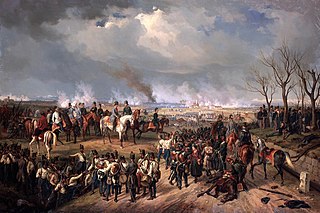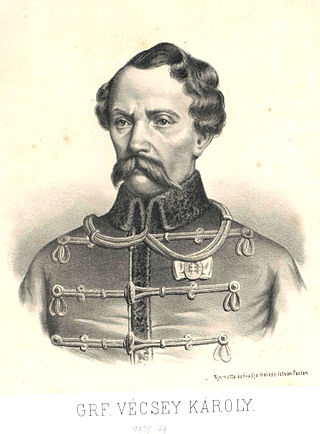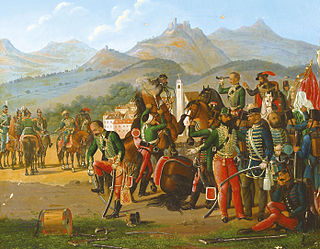
1849 (MDCCCXLIX) was a common year starting on Monday of the Gregorian calendar and a common year starting on Saturday of the Julian calendar, the 1849th year of the Common Era (CE) and Anno Domini (AD) designations, the 849th year of the 2nd millennium, the 49th year of the 19th century, and the 10th and last year of the 1840s decade. As of the start of 1849, the Gregorian calendar was 12 days ahead of the Julian calendar, which remained in localized use until 1923.

The Revolutions of 1848 in the Austrian Empire were a set of revolutions that took place in the Austrian Empire from March 1848 to November 1849. Much of the revolutionary activity had a nationalist character: the Empire, ruled from Vienna, included ethnic Germans, Hungarians, Slovenes, Poles, Czechs, Slovaks, Ruthenians (Ukrainians), Romanians, Croats, Venetians and Serbs; all of whom attempted in the course of the revolution to either achieve autonomy, independence, or even hegemony over other nationalities. The nationalist picture was further complicated by the simultaneous events in the German states, which moved toward greater German national unity.

Artúr Görgei de Görgő et Toporc was a Hungarian military leader renowned for being one of the greatest generals of the Hungarian Revolutionary Army.

Count Josip Jelačić von Bužim was a Croatian lieutenant field marshal in the Imperial Austrian Army and politician. He was the Ban of Croatia between 23 March 1848 and 19 April 1859. He was a member of the House of Jelačić and a noted army general, remembered for his military campaigns during the Revolutions of 1848 and for his abolition of serfdom in Croatia.

György (Móric) Klapka was a Hungarian general. He was one of the most important Hungarian generals of the Hungarian War of Independence of 1848–1849, politician, member of the Hungarian Parliament, and deputy War Minister.

János Damjanich was an Austrian military officer who became general of the Hungarian Revolutionary Army in 1848. He is considered a national hero in Hungary.

The Hungarian Revolution of 1848 or fully Hungarian Civic Revolution and War of Independence of 1848–1849 was one of many European Revolutions of 1848 and was closely linked to other revolutions of 1848 in the Habsburg areas. Although the revolution failed, it is one of the most significant events in Hungary's modern history, forming the cornerstone of modern Hungarian national identity - the anniversary of the Revolution's outbreak, 15 March, is one of Hungary's three national holidays.
Habsburg–Ottoman wars in Hungary, from 1526 to 1568, were wars between the Habsburg monarchy and the Ottoman Empire, waged on the territory of the Kingdom of Hungary and several adjacent lands in Southeastern Europe. The Habsburgs and the Ottomans engaged in a series of military campaigns against one another in Hungary between 1526 and 1568. While overall the Ottomans had the upper hand, the war failed to produce any decisive result. The Ottoman army remained very powerful in the open field but it often lost a significant amount of time besieging the many fortresses of the Hungarian frontier and its communication lines were now dangerously overstretched. At the end of the conflict, Hungary had been split into several different zones of control, between the Ottomans, Habsburgs, and Transylvania, an Ottoman vassal state. The simultaneous war of succession between Habsburg-controlled western "Royal Hungary" and the Zápolya-ruled pro-Ottoman "Eastern Hungarian Kingdom" is known as the Little War in Hungary.

The city of Budapest was officially created on 17 November 1873 from a merger of the three neighboring cities of Pest, Buda and Óbuda. Smaller towns on the outskirts of the original city were amalgamated into Greater Budapest in 1950. The origins of Budapest can be traced to Celts who occupied the plains of Hungary in the 4th century BC. The area was later conquered by the Roman Empire, which established the fortress and town of Aquincum on the site of today's Budapest around AD 100. The Romans were expelled in the 5th century by the Huns, who were challenged by various tribes during the next several centuries. The Hungarian conquest of the Carpathian Basin started at the end of the 9th century, and the Kingdom of Hungary was established at the end of the 11th century.

Count Károly Vécsey de Hernádvécse et Hajnácskő was a honvéd general in the Hungarian Army. He was executed for his part in the Hungarian Revolution of 1848, and is considered one of the 13 Martyrs of Arad.

The siege of Buda ended with the capture of the city of Buda, Hungary by the Ottoman Empire, leading to 150 years of Ottoman control of Hungary. The siege, part of the Little War in Hungary, was one of the most important Ottoman victories over the Habsburg monarchy during Ottoman–Habsburg wars in Hungary and the Balkans.

The Surrender at Világos, which was the formal end of the Hungarian Revolution of 1848, took place on 13 August 1849, at Világos,. The terms were signed by Hungarian General Artúr Görgey on the rebels' side and Count Theodor von Rüdiger of the Russian Imperial Army. Following the capitulation, General Julius Jacob von Haynau was appointed Imperial plenipotentiary in the country and brutally re-subjugated it.

The Battle of Isaszeg took place in the Spring Campaign of the Hungarian War of Independence from 1848 to 1849, between the Austrian Empire and the Hungarian Revolutionary Army supplemented by Polish volunteers. The Austrian forces were led by Field Marshal Alfred I, Prince of Windisch-Grätz and the Hungarians by General Artúr Görgei. The battle was one of the turning points of the Hungarian War of Independence, being the decisive engagement of the so-called Gödöllő operation, and closing the first phase of the Spring Campaign.

The Hungarian State was a short-lived state that existed for 4 months in the last phase of the Hungarian Revolution of 1848–49.

The Spring Campaign, named also the Glorious Spring Campaign is the military campaign of the Hungarian Revolutionary Army against the forces of the Habsburg Empire in Middle and Western Hungary during the Hungarian Revolution of 1848 between 2 April and 21 May 1849, which resulted in the liberation of almost the whole territory of Hungary from the Habsburg forces.

The Battle of Tápióbicske was a battle in the Spring Campaign of the Hungarian War of Independence (1848–1849), fought on 4 April 1849 between the Austrian Empire and the Hungarian Revolutionary Army. The Habsburg forces consisted of the I Corps of the Imperial Army led by Lieutenant Field Marshal Josip Jelačić. The Hungarians deployed I and III Corps led by General György Klapka and General János Damjanich respectively. Although initially the careless soldiers of the I. corps were put to flight by the Croatian and Austrian soldiers, after entering in their trap, the Hungarians were victorious, thanks to the intervention of the III. corps, and the main Hungarian armies could advance towards the Hungarian capitals, forcing the Austrian high commander, Field Marshal Alfred I, Prince of Windisch-Grätz fight a decisive battle at Isaszeg, which would decide the fate of Central and Western Hungary until the intervention of the Russian forces on the Habsburg side in June 1849.

The Battle of Vác, fought on 10 April 1849, was one of two important battles which took place in Vác during the Spring Campaign of the Hungarian War of Independence between the Austrian Empire and the Hungarian revolutionary army. The battle was the starting point of the second phase of the Spring Campaign, during which the Hungarians planned to relieve the fortress of Komárom from an Austrian siege, and to encircle the Austrian forces headquartered in the Hungarian capitals of Buda and Pest.

The Battle of Nagysalló, fought on 19 April 1849, was one of the battles between the Habsburg Empire and the Hungarian Revolutionary Army during the Spring Campaign in the Hungarian War of Independence from 1848–1849, fought between the Habsburg Empire and the Hungarian Revolutionary Army. Until 1918 Nagysalló was part of the Kingdom of Hungary; nowadays it is a village in Slovakia, its Slovakian name being Tekovské Lužany. This was the second battle in the second phase of the campaign, whose aim was to break the imperial siege of the fortress of Komárom and at the same time encircle the Habsburg imperial forces headquartered in the Hungarian capitals of Buda and Pest. The Hungarians routed the imperial corps led by Lieutenant General Ludwig von Wohlgemuth, which had come from the Habsburg Hereditary Lands, to help the imperial army sent to suppress the Hungarian Revolution of 1848 and independence.

The First battle of Komárom was one of the most important battles of the Hungarian War of Independence, fought on 26 April 1849, between the Hungarian and the Austrian Imperial main armies, which some consider ended as a Hungarian victory, while others say that actually it was undecided. This battle was part of the Hungarian Spring Campaign. After the revolutionary army attacked and broke the Austrian siege of the fortress, the Imperials, having received reinforcements which made them numerically very superior to their enemies, successfully counterattacked, but after stabilising their situation, they retreated towards Győr, leaving the trenches and much of their siege artillery in Hungarian hands. By this battle the Hungarian revolutionary army relieved the fortress of Komárom from a very long imperial siege, and forced the enemy to retreat to the westernmost margin of the Kingdom of Hungary. After this battle, following a long debate among the Hungarian military and political leaders about whether to continue their advance towards Vienna, the Habsburg capital, or towards the Hungarian capital, Buda, whose fortress was still held by the Austrians, the second option was chosen.

The siege of Buda took place at Buda castle, part of the twin capital cities of the Kingdom of Hungary. The Hungarian revolutionary army was led by General Artúr Görgei during the Hungarian War of Independence. Part of the Spring Campaign, the siege began on 4 May 1849, ending with the Hungarian capture of the castle by assault on 21 May.



















